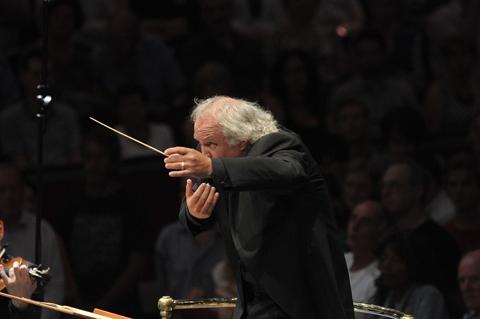Leonard Tanner, my old choirmaster, used to say that Brahms was a composer with his feet in three different camps: the Baroque period, the Classical period, and the Romantic. Possibly he had a fourth leg too, poking into the music of the future. Composers adept at these multiple postures filled Thursday’s sometimes lustrous orchestral Prom given by the BBC Scottish Symphony Orchestra and their chief conductor Donald Runnicles. Brahms was represented of course (the Second Symphony); also the great nostalgist Richard Strauss, watering his old age and the wasteland of defeated Germany with his Four Last Songs.
First up, though, was a new work, a Fifth Concerto for Orchestra, from that unique British treasure Robin Holloway, a composer whose music often appears to live in at least two centuries at once. Four years ago his Fourth Concerto – most composers never get past one – proved so bulky that a movement had to be lopped off its premiere in San Francisco; even then, it lasted over an hour. This time, Holloway was ordered to watch the clock. “Nothing gigantic,” his BBC commissioners told him; “and nothing more than 20 minutes.”
Oh well, in performance it lasted 28, and many of them were worth it, though the work did give the impression of being a concatenation of aural niceties in search of a viable form. That impression was heightened by the sudden announcement that the order of movements at this world premiere would be changed. What had been considered the third movement now became the last: its natural status, I would have thought, since this Allegro enfatico came at us with whooping brass and ended with an applause-whipping crescendo. Still, some jostling for position seems fitting for a piece designed to be concentrated and dense, stacked up in Holloway’s eyes like a skyscraper in Manhattan, built “high into the sky and deep into the rock”.
Living in this Manhattan we find various of Holloway’s old friends: the pressurised Expressionist canvases of Schoenberg’s Five Orchestral Pieces; Strauss at his most iridescent and opulent; the harmonic ghost of Brahms; for a few bars even Hindemith, note-spinning as he walks the dog. Like Schoenberg, Holloway has also taken inspiration from the emotional sensation of colours. The first movement, notably cramped and claustrophobic, is a “black” movement; the new finale sings the praise of pillar-box red; the second was prompted by the spectacle of a sun-kissed green lawn; and so on. What the ear hears, though, is not colour per se, but Holloway’s continuing confidence and invention in conjuring a kaleidoscope of fantastical textures from a large orchestra. Soap bubbles rising up, glistening with harp and celesta; a susurration of woodwinds; queasy harmonies, sickly as the muggy air; the list is long. Stunning effects, every one; though they’re not always, at a first listening, easy to grasp structurally as they tumble from Holloway’s idiosyncratic brain. Quite undeterred, Runnicles and his Scottish forces delivered a virtuosic and bristling account of this most enigmatic entertainment.
The orchestra also made memorable sounds in Strauss’s Four Last Songs; more memorable, alas, than those of the Swedish soprano Hillevi Martinpelto. Where was the lustre, the voluptuous ache, that this music needs? Locked in a cupboard somewhere, it seemed. With hindsight it wasn’t good sense for her to tell her interviewer in the programme booklet that the Albert Hall’s ringing acoustic would “carry her voice”. Because it didn’t; certainly not enough to let the music take wing. Some ungainly scooped notes, too.
So I move swiftly on to Brahms’s Second Symphony. This was given a sumptuously mellifluous reading. You could tell that Runnicles is a Wagner man by his relish of the music’s long singing lines, though the flow of notes never concealed the symphony's streaks of dark melancholy. And inside Runnicles’s bubbling stream lay many penetrating moments: the Allegretto’s precisely judged pauses, like the teasing flick of a dancer’s skirt; the gradual shift from the Adagio’s grief into a mood of calm acceptance; the finale’s concluding acceleration into dizzy excitement. I could go on. A noble and significant interpretation.
Wonders of a different order arrived with the late-night Prom from the Tallis Scholars and their indefatigable conductor Peter Phillips. On the platform 12 singers stood in a semi-circle, surrounded by empty space; yet they made as penetratingly thrilling a sound as all those battalions heard a few weeks ago in Havergal Brian’s Gothic Symphony. Singing nothing but Tomás Luis de Victoria helped: you can’t beat Spain’s leading musical ornament of the 16th century for emotional power allied to comparatively simple means. He’s long been the pet of the Tallis Scholars, and the audience sat rapt as Phillips’s team lifted us into heaven. The balance of parts; the expressive ease; the breathtaking beauty of their pianissimos! Occasionally I wanted to smooth away the sharp edge that the male voices (tenors especially) acquired when letting rip; but apart from those flecks in the blend, what could possibly be criticised?
Certainly not the music. Dum complerentur offered alleluias pealing like bells. The grave beauty of the Lamentations for Good Friday sent us to our knees. But neither could top the Officium defunctorum, a requiem setting alive to drama yet bathed in the oils of consolation. Riveting, and deeply moving; and I’m afraid way beyond the abilities of Mr Tanner’s old choir.















Add comment